
A digital camera, also called a digicam, is a camera that captures photographs in digital memory. Most cameras produced today are digital, largely replacing those that capture images on photographic film or film stock. Digital cameras are now widely incorporated into mobile devices like smartphones with the same or more capabilities and features of dedicated cameras. High-end, high-definition dedicated cameras are still commonly used by professionals and those who desire to take higher-quality photographs.
A barcode reader or barcode scanner is an optical scanner that can read printed barcodes and send the data they contain to computer. Like a flatbed scanner, it consists of a light source, a lens, and a light sensor for translating optical impulses into electrical signals. Additionally, nearly all barcode readers contain decoder circuitry that can analyse the barcode's image data provided by the sensor and send the barcode's content to the scanner's output port.

An image scanner is a device that optically scans images, printed text, handwriting, or an object and converts it to a digital image. The most common type of scanner used in offices and in the home is the flatbed scanner, where the document is placed on a glass window for scanning. A sheetfed scanner, which moves the page across an image sensor using a series of rollers, may be used to scan one document at a time or multiple, as in an automatic document feeder. A handheld scanner is a portable version of an image scanner that can be used on any flat surface. Scans are usually downloaded to the computer that the scanner is connected to, although some scanners are able to store scans on standalone flash media.

A Nipkow disk, also known as scanning disk, is a mechanical, rotating, geometrically operating image scanning device, patented by Paul Gottlieb Nipkow in Berlin. This scanning disk was a fundamental component in mechanical television, and thus the first televisions, through the 1920s and 1930s.

A digital camera back is a device that attaches to the back of a camera in place of the traditional negative film holder and contains an electronic image sensor. This allows cameras that were designed to use film take digital photographs. These camera backs are generally expensive by consumer standards and are primarily built to be attached on medium- and large-format cameras used by professional photographers.

Mechanical television or mechanical scan television is an obsolete television system that relies on a mechanical scanning device, such as a rotating disk with holes in it or a rotating mirror drum, to scan the scene and generate the video signal, and a similar mechanical device at the receiver to display the picture. This contrasts with vacuum tube electronic television technology, using electron beam scanning methods, for example in cathode-ray tube (CRT) televisions. Subsequently, modern solid-state liquid-crystal displays (LCD) and LED displays are now used to create and display television pictures.

Infrared homing is a passive weapon guidance system which uses the infrared (IR) light emission from a target to track and follow it seamlessly. Missiles which use infrared seeking are often referred to as "heat-seekers" since infrared is radiated strongly by hot bodies. Many objects such as people, vehicle engines and aircraft generate and emit heat and so are especially visible in the infrared wavelengths of light compared to objects in the background.
A time delay and integration or time delay integration (TDI) charge-coupled device (CCD) is an image sensor for capturing images of moving objects at low light levels. While using similar underlying CCD technology, in operation it contrasts with staring arrays and line scanned arrays. It works by synchronized mechanical and electronic scanning, so that the effects of dim imaging targets on the sensor can be integrated over longer periods of time.

A coordinate-measuring machine (CMM) is a device that measures the geometry of physical objects by sensing discrete points on the surface of the object with a probe. Various types of probes are used in CMMs, the most common being mechanical and laser sensors, though optical and white light sensors do exist. Depending on the machine, the probe position may be manually controlled by an operator, or it may be computer controlled. CMMs(coordinate-measuring machine) specify a probe's position in terms of its displacement from a reference position in a three-dimensional Cartesian coordinate system. In addition to moving the probe along the X, Y, and Z axes, many machines also allow the probe angle to be controlled to allow measurement of surfaces that would otherwise be unreachable.

3D scanning is the process of analyzing a real-world object or environment to collect three dimensional data of its shape and possibly its appearance. The collected data can then be used to construct digital 3D models.

High-speed photography is the science of taking pictures of very fast phenomena. In 1948, the Society of Motion Picture and Television Engineers (SMPTE) defined high-speed photography as any set of photographs captured by a camera capable of 69 frames per second or greater, and of at least three consecutive frames. High-speed photography can be considered to be the opposite of time-lapse photography.

Hyperspectral imaging collects and processes information from across the electromagnetic spectrum. The goal of hyperspectral imaging is to obtain the spectrum for each pixel in the image of a scene, with the purpose of finding objects, identifying materials, or detecting processes. There are three general types of spectral imagers. There are push broom scanners and the related whisk broom scanners, which read images over time, band sequential scanners, which acquire images of an area at different wavelengths, and snapshot hyperspectral imagers, which uses a staring array to generate an image in an instant.
Laser scanning is the controlled deflection of laser beams, visible or invisible. Scanned laser beams are used in some 3-D printers, in rapid prototyping, in machines for material processing, in laser engraving machines, in ophthalmological laser systems for the treatment of presbyopia, in confocal microscopy, in laser printers, in laser shows, in Laser TV, and in barcode scanners. Applications specific to mapping and 3D object reconstruction are known as 3D laser scanner.

Scanography, more commonly referred to as scanner photography, is the process of capturing digitized images of objects for the purpose of creating printable art using a flatbed "photo" scanner with a CCD array capturing device. Fine art scanography differs from traditional document scanning by using atypical objects, often three-dimensional, as well as from photography, due to the nature of the scanner's operation.
Document cameras, also known as visual presenters, visualizers, digital overheads, or docucams, are high-resolution, real-time image capture devices used to display an object to a large audience, such as in a classroom or a lecture hall. They can also serve as replacements for image scanners. Similar to opaque projectors, document cameras can magnify and project the images of actual, three-dimensional objects, as well as transparencies.
A structured-light 3D scanner is a device that measures the three-dimensional shape of an object by projecting light patterns—such as grids or stripes—onto it and capturing their deformation with cameras. This technique allows for precise surface reconstruction by analyzing the displacement of the projected patterns, which are processed into detailed 3D models using specialized algorithms.

In computing, an input device is a piece of equipment used to provide data and control signals to an information processing system, such as a computer or information appliance. Examples of input devices include keyboards, computer mice, scanners, cameras, joysticks, and microphones.

Strip photography, or slit photography, is a photographic technique of capturing a two-dimensional image as a sequence of one-dimensional images over time, in contrast to a normal photo which is a single two-dimensional image at one point in time. A moving scene is recorded, over a period of time, using a camera that observes a narrow strip rather than the full field. If the subject is moving through this observed strip at constant speed, they will appear in the finished photo as a visible object. Stationary objects, like the background, will be the same the whole way across the photo and appear as stripes along the time axis; see examples on this page.
Sensors for arc welding are devices which – as a part of a fully mechanised welding equipment – are capable to acquire information about position and, if possible, about the geometry of the intended weld at the workpiece and to provide respective data in a suitable form for the control of the weld torch position and, if possible, for the arc welding process parameters.

X-ray computed tomography operates by using an X-ray generator that rotates around the object; X-ray detectors are positioned on the opposite side of the circle from the X-ray source.
















